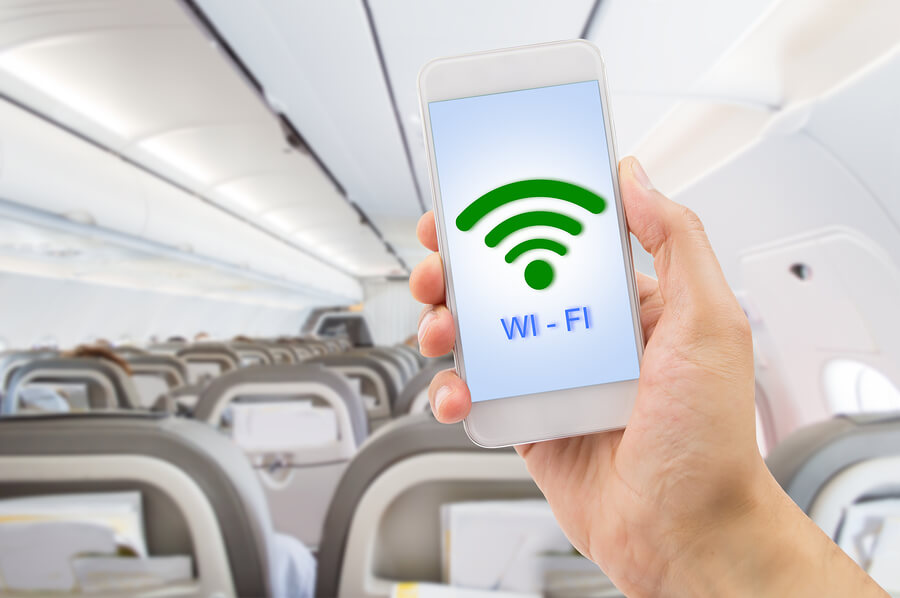WELCOME TO OUR TRAVEL BLOG
Airline Wifi Getting Faster in 2016
Staying connected in-flight may soon get easier
It’s exciting to be at 30,000 feet above the ground. Flight attendants are there to serve you, the view is great, and you are cutting your travel time down drastically. One thing that isn’t up to snuff is the WiFi. Sure you can send a few tweets and maybe scan your email, but video live-streaming of your favorite show is pretty much impossible.
This is a very common problem among airlines when it comes to in-flight WiFi connections. The connection is unreliable, and you’d be better off sleeping than wait for your download to finish. The slow speed is attributed to the low bandwidth airline WiFi systems have. Divide this among passengers and you’ll get a picture of what frustration looks like inside every air vessel, except for a few airlines.
Big Four Airline Wifi Suppliers
There are four main suppliers of WiFi in the United States: Gogo, Panasonic Avionics, Global Eagle and Thales.
Thales currently supplies connection to flights from JetBlue and United Airlines and those airlines have been ranked by users as having the ‘Best WiFi’. What makes Thales a desirable WiFi supplier option is its utilization of space-borne Ka-band satellites. Compared to Ku-band satellites systems, it delivers stronger connection at 12 Mbps. It’s got the best download speed as far as inflight WiFi goes today. This speed is delivered, undivided, into every phone, laptop or tablet within the aircraft.
At least 11 airlines including American, Delta and a number from United get their supply from Gogo, which delivers a connection of at least 10Mbps to be divided among users on the plane. The company’s spokesman has claimed that Gogo holds at least 70% market share of U.S. domestic flights. International carriers like Air Canada, Japan Airlines also use Gogo’s WiFi supply.
There are a variety of satellite systems Gogo uses to satisfy their customers on air. Air-to ground (ATG)-good for mobility service, delivers a frequency of about 10 Mbps. All over the U.S., Alaska, and Canada, Gogo has about 160 towers that receive signals from above, then directs this signal back to the air to be ‘received’ by planes. They also have Ku-band satellite systems. And while this is a good investment, the speed runs at about 3-8 Mbps, to be shared among all users within the plane.
Panasonic Avionics, on the other hand, is well-known for providing broadband connectivity using Ku band network systems to the aviation market. Just this March, they entered into an agreement to acquire ITC Global, boosting their service throughout the aviation and maritime field. Global Eagle, another leader in the field, supplies international as well as domestic flights using space-borne satellite systems.
New innovations for airline WiFi set to launch
To date, only JetBlue and United flights have WiFi connectivity capable of video streaming and download using Thales’ service. Yet its other three competitors are set to launch their new innovations within this year.
High Throughput Satellites
SES has signed up with Global Eagle and Panasonic to provide and HighThroughput Saltellites for Panasonic Avionics and Global Eagle High Throughput satellites employ frequency re-use and spot-beam technology and works by targeting their signals into places where airline traffic is heavy, using spot-beams. By focusing to where it’s needed the most, airlines can see an upgrade from the usual 3-10 Mbps to a staggering speed of 70Mbps. There’s even a claim that Panasonic Avionics’s speed can reach a frequency of up to 200 Mbps. If this happens, live-streaming and video calling will just be a piece of cake at 30,000 feet above ground. Boosting the bandwidth means costs will lower too. Airline carriers like Southwest will be
2Ku Technology
While Global Eagle and Panasonic are just polishing and waiting for their schedules, Gogo is rolling out its 2Ku technology. Compared with Ku-band satellite systems they previously used, 2Ku technology will have aircrafts use two flat panel antennas (one for download, another for upload) for better reception. 2Ku will offer a speed of 70 Mbps. Five hundred planes from at least 7 airlines have already signed up for it. It is expected that airline carriers such as Delta and Aeromexico, among others, will be seeing this upgrade as soon as the satellites are airborne.
Take advantage of faster WiFi on your next flight. Get great deals for your business class travel with letsflycheaper.com.



